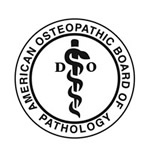American Osteopathic Board of Pathology
| Classification |
|
|---|---|
| External resources |
|
The American Osteopathic Board of Pathology (AOBPa) is a professional organization in the United States that provides board certification to osteopathic physicians specializing in the field of pathology. The AOBPa is one of the eighteen specialty certifying boards of the American Osteopathic Association Bureau of Osteopathic Specialists (AOABOS).
History[edit | edit source]
The AOBPa was established to ensure that osteopathic physicians specializing in pathology meet the highest standards of practice. The board was created to provide a pathway for osteopathic pathologists to achieve certification, which is a mark of excellence and a testament to their expertise in the field.
Certification Process[edit | edit source]
The certification process for the AOBPa involves several steps. Candidates must first complete an accredited residency program in pathology. Following this, they are eligible to sit for the board certification examination, which tests their knowledge and skills in various areas of pathology.
The examination is comprehensive, covering topics such as anatomic pathology, clinical pathology, and forensic pathology. Successful candidates are awarded board certification, which is valid for a period of ten years. To maintain certification, diplomates must participate in the Osteopathic Continuous Certification (OCC) process, which includes ongoing learning and assessment activities.
Subspecialties[edit | edit source]
The AOBPa offers certification in several subspecialties of pathology, allowing physicians to demonstrate expertise in specific areas. These subspecialties include:
Each subspecialty has its own set of requirements and examinations, tailored to the specific knowledge and skills needed in that area.
Role and Importance[edit | edit source]
The AOBPa plays a crucial role in maintaining the standards of osteopathic pathology practice. By certifying qualified physicians, the board ensures that patients receive care from professionals who are knowledgeable and skilled in the latest advancements in pathology.
Board certification by the AOBPa is recognized as a significant achievement and is often required for employment in many healthcare settings. It signifies a commitment to lifelong learning and excellence in the field of pathology.
Related Pages[edit | edit source]
Search WikiMD
Ad.Tired of being Overweight? Try W8MD's physician weight loss program.
Semaglutide (Ozempic / Wegovy and Tirzepatide (Mounjaro / Zepbound) available.
Advertise on WikiMD
|
WikiMD's Wellness Encyclopedia |
| Let Food Be Thy Medicine Medicine Thy Food - Hippocrates |
Translate this page: - East Asian
中文,
日本,
한국어,
South Asian
हिन्दी,
தமிழ்,
తెలుగు,
Urdu,
ಕನ್ನಡ,
Southeast Asian
Indonesian,
Vietnamese,
Thai,
မြန်မာဘာသာ,
বাংলা
European
español,
Deutsch,
français,
Greek,
português do Brasil,
polski,
română,
русский,
Nederlands,
norsk,
svenska,
suomi,
Italian
Middle Eastern & African
عربى,
Turkish,
Persian,
Hebrew,
Afrikaans,
isiZulu,
Kiswahili,
Other
Bulgarian,
Hungarian,
Czech,
Swedish,
മലയാളം,
मराठी,
ਪੰਜਾਬੀ,
ગુજરાતી,
Portuguese,
Ukrainian
Medical Disclaimer: WikiMD is not a substitute for professional medical advice. The information on WikiMD is provided as an information resource only, may be incorrect, outdated or misleading, and is not to be used or relied on for any diagnostic or treatment purposes. Please consult your health care provider before making any healthcare decisions or for guidance about a specific medical condition. WikiMD expressly disclaims responsibility, and shall have no liability, for any damages, loss, injury, or liability whatsoever suffered as a result of your reliance on the information contained in this site. By visiting this site you agree to the foregoing terms and conditions, which may from time to time be changed or supplemented by WikiMD. If you do not agree to the foregoing terms and conditions, you should not enter or use this site. See full disclaimer.
Credits:Most images are courtesy of Wikimedia commons, and templates, categories Wikipedia, licensed under CC BY SA or similar.
Contributors: Prab R. Tumpati, MD

